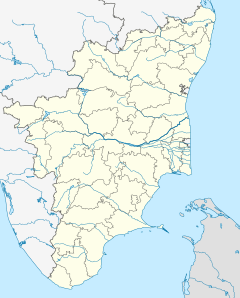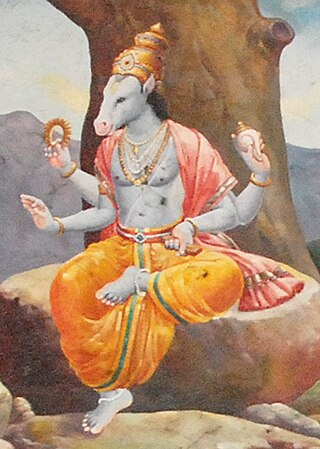
Hayagriva is a Hindu deity, the horse-headed avatar of Vishnu. The purpose of this incarnation was to slay a danava also named Hayagriva, who had the neck of a horse and the body of a human.

Uthamar Kovil in Uthamarkoil, a village in the outskirts of Tiruchirappalli in the South Indian state of Tamil Nadu, is dedicated to the Hindu Trimurti of Vishnu, Shiva, and Brahma. Constructed in the Dravidian style of architecture, the temple is glorified in the Nalayira Divya Prabandham, the early medieval Tamil canon of the Alvar saints from the 6th–9th centuries CE. It is one of the 108 Divya Desams dedicated to Vishnu, who is worshipped as Purushothaman Perumal and his consort Lakshmi as Poornavalli Thayar.
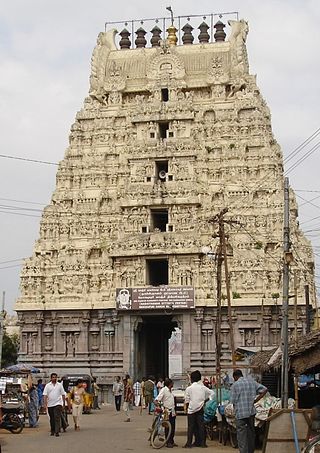
The Kamakshi Amman Temple, also known as Kamakoti Nayaki Kovil, is a Hindu temple dedicated to the goddess Kamakshi, one of the highest aspects of Adi Parashakti, the supreme goddess in Shaktism. The temple is located in the historic city of Kanchipuram, near Chennai, India.

Tiruvelukkai located in Kanchipuram in the South Indian state of Tamil Nadu, is dedicated to the Hindu god Vishnu. Constructed in the Dravidian style of architecture, the temple is glorified in the Nalayira Divya Prabandham, the early medieval Tamil canon of the Alvar saints from the 6th–9th centuries CE. It is one of the 108 Divya Desams dedicated to Vishnu, who is worshipped as Aḻagiya Singar (Narasimha) and his consort Lakshmi as Amruthavalli.

The Ashtabujakaram or Ashtabuja Perumal Temple located in Kanchipuram in the South Indian state of Tamil Nadu, is dedicated to the Hindu god Vishnu. Constructed in the Dravidian style of architecture, the temple is glorified in the Nalayira Divya Prabandham, the early medieval Tamil canon of the Alvar saints from the 6th–9th centuries CE. It is one of the 108 Divya Desams dedicated to Vishnu, who is worshipped as Ashta Bhuja Perumal and his consort Lakshmi as Alamelumangai.

Hara Saabha Vimochana Perumal Temple in Thirukandiyur, a village in the outskirts of Thiruvayaru in the South Indian state of Tamil Nadu, is dedicated to the Hindu god Vishnu. Constructed in the Dravidian style of architecture, the temple is glorified in the Nalayira Divya Prabandham, the early medieval Tamil canon of the Alvar saints from the 6th–9th centuries CE. It is one of the 108 Divya Desam dedicated to Vishnu, who is worshipped as Hara Saabha Vimochana Perumal and his consort Lakshmi as Kamalavalli Nachiyar.

Thenupuriswarar Temple is a Hindu temple dedicated to the god Shiva located in the village of Patteeswaram, Tamil Nadu, India. Shiva is worshiped as Thenupuriswarar, and is represented by the lingam. His consort Parvati is depicted as Nyanambikai (Somakamalambigai). The presiding deity is revered in the 7th century Tamil Saiva canonical work, the Tevaram, written by Tamil saint poets known as the Nayanars and classified as Paadal Petra Sthalam. The temple is associated with the legend of Sambandar to whose view Nandi moved to have a direct view of the presiding deity. Muthupandal festival celebrated in the temple in associated with the legend.
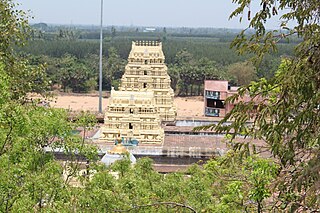
Devanatha Hemabhujavalli Temple is a Hindu temple in Thiruvanthipuram, a village in the outskirts of Cuddalore in the South Indian state of Tamil Nadu, dedicated to the god Vishnu and goddess Lakshmi. Constructed in the Dravidian style of architecture, the temple is glorified in the Nalayira Divya Prabandham, the early medieval Tamil canon of the Alvar saints from the 6th–9th centuries CE. It is one of the 108 Divya Desams dedicated to Vishnu, who is worshipped as Devanatha and Lakshmi as Hemabhujavalli. Though the presiding deity is Devanatha and Hemabhujavalli, the temple is known for Hayagriva, the ninth avatara of Vishnu in the Dashavatara of Vishnu and a god of knowledge. The temple is the only historical temple in South India to have a shrine of Hayagriva on hilltop.

Kandeeswarar Temple is a Hindu temple dedicated to the god Shiva located in Kandiyur also known as Thirukkandiyur or Tirukkandiyur, near Tiruvaiyaru, Tamil Nadu, India. Shiva is worshiped as Kandeeswarar, and is represented by the lingam and his consort Parvati is depicted as Mangalanayagi. The presiding deity is revered in the 7th century Tamil Saiva canonical work, the Tevaram, written by Tamil poet saints known as the nayanars and classified as Paadal Petra Sthalam. As per legends, Shiva is believed to have destroyed eight different demons and the eight Ashta Veeratanam temples are built signifying each of his victories in the war. The temple is one of the eight where Shiva is believed to have removed one of the five heads of Brahma.

Aiyarappar is a Hindu temple dedicated to Shiva located in the village of Tiruvaiyaru, Tamil Nadu, India. Shiva is worshiped as Aiyarappar, and is represented by the lingam and his consort Parvati is depicted as AramValarthaNaayagi. The presiding deity is revered in the 7th century Tamil Saiva canonical work, the Tevaram, written by Tamil poet saints known as the nayanars and classified as Paadal Petra Sthalam.

The Saranathan Temple in Thirucherai, a village on the outskirts of Kumbakonam in the South Indian state of Tamil Nadu, is dedicated to the Hindu god Vishnu. The temple is glorified in the Nalayira Divya Prabandham, the early medieval Tamil canon of the Alvar saints from the 6th–9th centuries CE. It is one of the 108 Divya Desams dedicated to Vishnu, who is worshipped as Saranathan and his consort Lakshmi as Saranayaki. It is believed that Saranathan appeared for Kaveri, the river goddess, who performed penance at this place.

Thanjai Mamani Koil is a set of three adjacent Hindu temples dedicated to Vishnu located in Thanjavur, Tamil Nadu, India. It is one of the Divya Desams, the 108 temples of Vishnu revered by the 12 poet saints called the Alvars. Unlike other Divya Desams where a single shrine is referenced, this set of temples is referred together in all the pasurams.
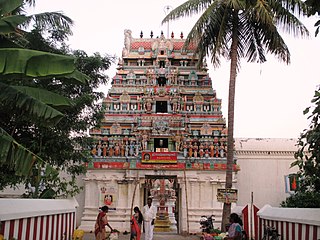
Nathan Kovil or Thiru Nandipura Vinnagaram Temple in Nathan Kovil, a village in the outskirts of Kumbakonam in the South Indian state of Tamil Nadu, is dedicated to the Hindu god Vishnu. Constructed in the Dravidian style of architecture, the temple is glorified in the Nalayira Divya Prabandham, the early medieval Tamil canon of the Alvar saints from the 6th–9th centuries CE. It is one of the 108 Divya Desams dedicated to Vishnu, who is worshipped as Jagannathan and his consort Lakshmi as Shenbagavalli.

Pallikondeswara Temple(also Pradosha kshetram) is a Hindu temple dedicated to the god Shiva located in Surutupalle, a village in Tirupati district of Andhra Pradesh, India. The presiding deity Pallikondeswara, unlike other Shiva temples, is sported in reclining posture lying on the lap of his consort Parvati.
Tiruvaneshwar Temple is a Shiva temple located at Ranganathapuram in the Thiruvaiyaru taluk of Thanjavur district in Tamil Nadu. The temple is dedicated to Shiva.

Pasupatheesvarar Temple is a Hindu temple dedicated to Lord Siva. It is located in Pasupathikoil of Thanjavur district, Tamil Nadu, India.
Rudrakodisvarar Temple is a Hindu temple dedicated to the deity Shiva, located at Sempankudi in Nagapattinam district in Tamil Nadu, India.
Saptharishishwarar Temple is a Hindu temple dedicated to the deity Shiva, located at Thudaiyur in Tiruchirapalli district, Tamil Nadu, India.

Singeeswarar Temple is a Shiva temple which is maintained under the control of Hindu Religious and Charitable Endowments Department, Government of Tamil Nadu in India.
